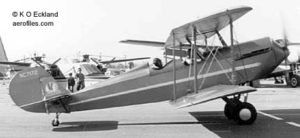
The Eagle is a three-place aircraft that was designed to be used as a trainer aircraft and also for “light commercial activity” of its era. Barnstormers (those going from town to town giving rides) doubled their profit ($5 per person) as they could give two people a ride around the patch when replacing the worn out surplus WW1 Curtiss Jenny’s they were using which carried only one person. As they rolled off the production line Eagles sold for about $2815.
During its initial production of 1928 and 1929 business was booming, but the stock market crash of late 1929 caused the bottom to fall out on sales. Hurting financially the American Eagle Aircraft Company merged with the Lincoln Aircraft Company, but the deepening economic depression caused the company to fail. During its six years of existence, the American Eagle Aircraft Company was the third largest producer of commercial aircraft in the world.
Our American Eagle was donated by Ted Homan & family of Santa Paula, CA in December 1971. The aircraft was restored in 1962 and won many awards at west coast fly-ins including Watsonville and Merced.
Unique Features of the American Eagle Biplane
The most notable feature of the American Eagle is that it has two wings that classify it as a “biplane.” In a biplane aircraft, both wings contribute to the total lift (the upward force on the airplane) although they do not produce twice as much lift as a single wing would create. As the airplane moves forward through the air the airflow around the two wings of a biplane interfere with each other resulting in inefficiencies.
When two sets of wings are used the wings have to be braced by wires and solid streamlined lengths of metal braces called “struts” to secure the wings in position and to absorb the forces on the wings in flight and on the ground. These devices have a resistance to the air that is moving over them in flight which is known as “drag.” In order to overcome the drag of these devices, additional power is required from the engine which overall will tend to slow the airplane in flight. This is a negative feature of a biplane as they require a lot more fuel to travel a given distance as compared with later more efficient designs.
On the positive side, biplanes have a good roll rate making them very maneuverable. They generally have a low stall speed (the speed at which the lift being generated can no longer support the airplane in flight) and can fly on very little engine power.
By the end of the 1930s engine power available had increased considerably, metallurgy had improved along with the engineering design of the internal wing structure so that the monoplane slowly took over and made the biplane obsolete for most purposes. Modern biplanes still exist today for special applications such as aerobatics and agricultural work.
| Aircraft Name | American Eagle 101 |
|---|---|
| Specifications | |
| Powerplant | Curtiss OXX-6 V8 water-cooled engine of 100hp |
| Propeller | Wood |
| Length | 24 ft |
| Height | 8 ft 4 in |
| Wingspan | 30 ft |
| Seats | 3 |
| Empty weight | 1227 lbs |
| Max gross weight | 2041 lbs |
| Performance | |
| Range | 385 mi |
| Max level speed, sea level | 85 mph |
